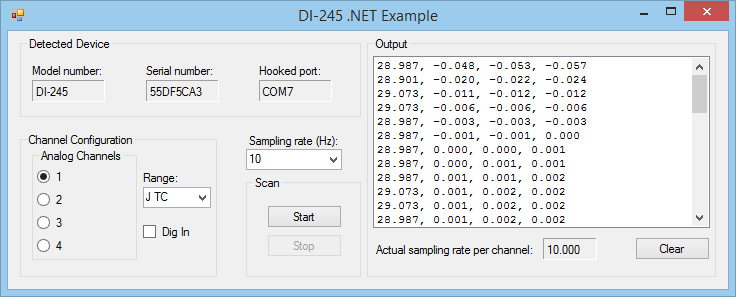We’ve released a new programming example for the DI-245 four-channel USB Voltage and Thermocouple DAQ that uses the Simple version of the interface to configure all aspects of the instrument. The example allows any channel to be configured for either thermocouple or voltage measurements. If programmed for voltage it allows any of the 12 selectable ranges to be programmed per channel. If programmed for TC measurements any one of eight TC types can be selected per channel. Any channel can also be disabled. Other programmable elements are sample rate and digital input channel. With that, all programmable aspects of the DI-245 are accessed in this single example program.
Operationally the VB.NET program allows you to configure a particular data acquisition setup, and then begin continuously scanning. Output is a text display in calibrated units. The program uses an efficient event trigger and handler routine to display in real time at the fastest DI-245 sample rate, so it represents an excellent foundation on which to build your own applications. And the .NET architecture easily transfers from VB to C# or any other .NET programming environment. Finally, the application is well-commented so you can easily grasp the essentials of DI-245 programming.
Download links follow:
Zipped DI-245 .NET Programming Example


 View Cart
View Cart sales@dataq.com
sales@dataq.com 330-668-1444
330-668-1444
2 Comments
Leonardo Donaire
Has anyone changed the code?
DaqGuy
If you refer to the DI-245 programming example, no. If you’re having a problem with the example program please open a support ticket at this link: https://www.dataq.com/support/ticket/ticket-form.html